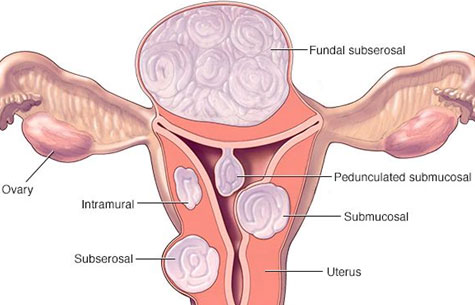Uterine Fibroids
Uterine fibroids, growths on the uterus that are noncancerous, are very common during the reproductive years. You can have a single fibroid or multiple, they can be small, or they can grow large and distort the uterus. Fibroids originate from a single cell, in the muscle tissue of the uterus, dividing repeatedly until it forms into a rubbery mass in which differs from surrounding tissue. Uterine fibroids are classified by location: Intramural (grow within the uterine wall), Submucosal (grow into the uterine cavity), Subserosal (grow towards the outside of the uterus) and Pedunculated (hanging from inside or outside the uterus).

SYMPTOMS
Uterine fibroids are quite common and can sometimes be asymptomatic. Women that have fibroids are often unaware of it due to not having any noticeable symptoms. Fibroids are not commonly linked to infertility. In women that do experience symptoms, they can vary depending on the amount of fibroids present, as well as the location and measurement of the fibroid. The most common signs and symptoms of uterine fibroids include:
- Heavy or painful menstrual bleeding
- Menstrual periods lasting more than a week
- Pelvic pressure or pain
- Frequent urination
- Difficulty emptying the bladder
- Constipation and bloating
- Pain during sex
- Back aches
CAUSES
While it remains unknown what exactly causes uterine fibroids to appear, it is certainly apparent that there are contributing factors in which affect them greatly including the following:
- Genetic changes:having a family history of uterine fibroids can increase the chance of you getting them as well. These genetic changes factor into the development of uterine fibroids.
- Hormones:the growth of uterine fibroids can be influenced by two important hormones, used for reproduction; estrogen and progesterone. There are more estrogen and progesterone receptors in uterine fibroids than there are in the normal uterine muscle, so the higher these levels increase (during pregnancy), the more the fibroid expands and when these levels drop (after giving birth or menopause), it causes fibroids to shrink.
- Other growth factors:insulin-like growth factor and insulin are thought to cause fibroid growth because these substances can stimulate cell proliferation in the tissue of fibroids.
- Extracellular Matrix (ECM):ECM can also play a role in the growth of uterine fibroids. ECM is the material that makes cells stick together, causing fibroids to develop.
DIAGNOSIS
Uterine fibroids are most commonly discovered by routine pelvic exam by feeling abnormalities within the shape of the uterus. If you have symptoms of uterine fibroids, the following tests are performed to confirm the diagnosis:
- Pelvic exam:for patients that have a history of known symptoms linked to uterine fibroids, a pelvic exam may be performed to determine the presence of a fibroid.
- Ultrasound:the presence of a fibroid can be detected by using a transvaginal probe to capture images of the uterine cavity.
- Hysterosonography (fluid test): fibroids can also be seen by imaging, with a transvaginal probe, when saline water is injected into the uterus through a thin catheter to expand the cavity and present any irregularities.
- Hysteroscopy: for a more in-depth look at the uterus, fibroids can be visualized through a lighted telescope that is inserted through the cervix and to the uterus. After injecting saline and expanding the cavity, the uterine walls are scoped out for any presence of fibroids.
TREATMENT
Depending on being symptomatic or not, fibroids are either treated by observation alone or treated with hormonal medication, and/or surgery to remove them completely. Being that most women experience few to no symptoms at all, the best option is watchful waiting as they tend to grow slow or shrink completely. If symptoms are severe, your doctor may prescribe hormonal medication to shrink the fibroid prior to a planned, minimally invasive procedure to remove it.
You will need the Adobe Reader to view and print these documents. 